Many drivers wonder if they can replace nitrogen with regular air in their tires. While looking for a way to keep tires inflated longer, especially in changing temperatures, some consider inflating them with nitrogen instead of air, or using a combination of the two. This guide can help you decide whether to fill your tires with nitrogen, air, or both.
In general, adding nitrogen to your tires is a typical up-sell tactic at tire shops. There are some benefits in motorsport, and it sounds good in theory, but for the typical car owner, sticking with normal air is perfectly fine. As long as you keep your tire pressures at the correct spec, you're good to go.
Nitrogen tires are filled with nitrogen instead of, or in addition to, regular air. The larger, slower-moving nitrogen molecules seep out of the tire more slowly, and some experts say this can help keep tires inflated longer. Using a combination of nitrogen and air in your tires won't harm them, but it might reduce the effectiveness of the nitrogen fill and cause your tires to deflate more quickly than if you used pure nitrogen. An accurate pressure gauge can help you maintain proper tire pressure, whether using nitrogen or air.
Filling your tires with nitrogen might provide benefits in these areas:
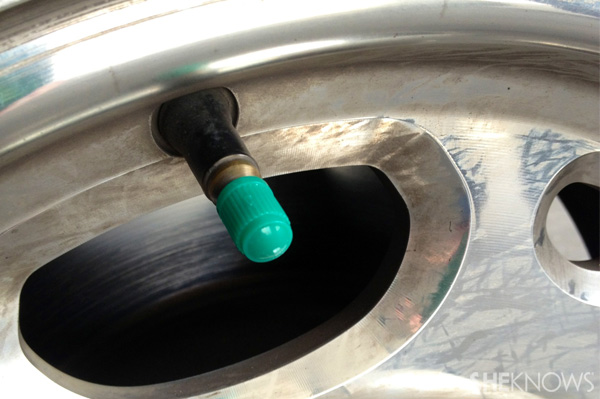
Any tire can be filled with nitrogen instead of air. Here are some considerations when using nitrogen in some common tire types:
Summer TiresStandard summer tires perform well in dry and wet conditions. They often perform best in summer weather or weather that is generally warm and dry. Using nitrogen in your summer tires might help you keep a consistent tire pressure when the temperature changes drastically, such as a cool summer night followed by a very hot day.
Snow TiresSnow tires, or winter tires, use special rubber and tread and sometimes even metal studs to handle wintry conditions such as snow and ice. Nitrogen's extreme weather benefits may be useful in cold conditions, and you might find that you lose less tire pressure during weather fluctuations than if you were to use nitrogen-free air.
All-Season TiresAll-season tires are a safe bet in areas with relatively moderate conditions, including temperate winters. They offer modest traction and don't need to be replaced seasonally. Filling your all-season tires with nitrogen might help you retain tire pressure through seasonal temperature shifts, especially when the seasons change.
They offer modest traction and don't need to be replaced seasonally. Filling your all-season tires with nitrogen might help you retain tire pressure through seasonal temperature shifts, especially when the seasons change.
Performance tires are often used for high-speed or luxury vehicles. They are often a low-profile, wide tire with shallow treads and increased traction in some conditions. Nitrogen offers the same benefits in performance tires as it does in other tire types, including less frequent top-offs.
Off-Road TiresOff-road tires are used for vehicles that can handle rough conditions such as rocks, mud, and deep snow. They are usually durable with deep tread. Using nitrogen in your off-road tires might help you control your tire pressure specifically for the conditions you expect out on the terrain.
Things to Think About when Considering Nitrogen for Your TiresWhen you are deciding whether to use nitrogen in your tires, keep these factors in mind:
 Most locations charge to fill your tires with nitrogen. You might also purchase tires that come pre-filled with nitrogen. Research nitrogen tire fill costs in your area and consider the expense before purchasing your tires. Remember that you might not have to refill your tires as often when you use nitrogen compared to air.
Most locations charge to fill your tires with nitrogen. You might also purchase tires that come pre-filled with nitrogen. Research nitrogen tire fill costs in your area and consider the expense before purchasing your tires. Remember that you might not have to refill your tires as often when you use nitrogen compared to air.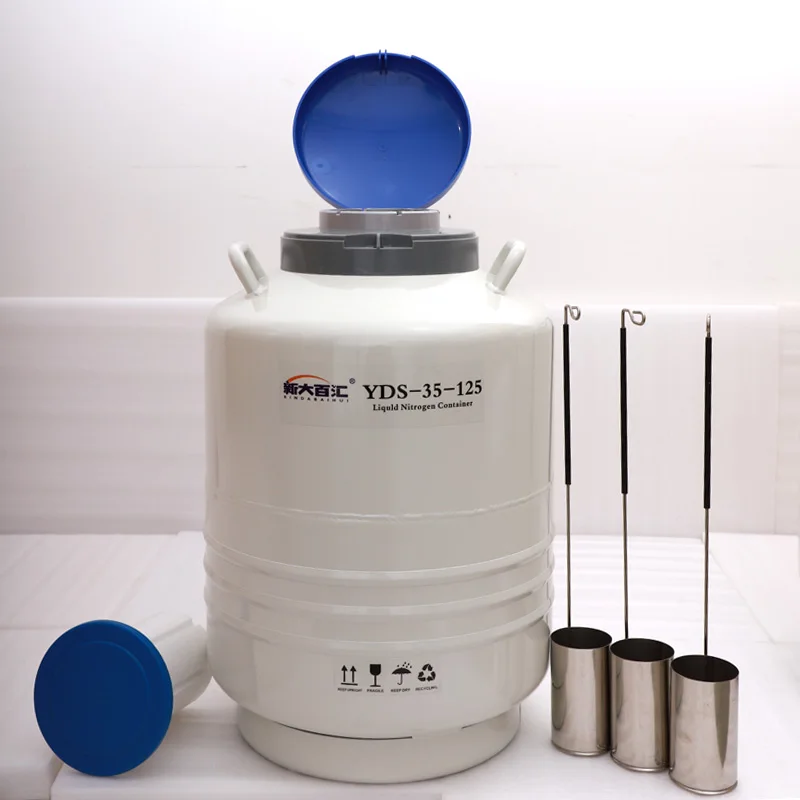 Ease of access might impact your decision to fill your tires with nitrogen, especially if you prefer to avoid mixing nitrogen and air to preserve the full benefits of nitrogen tires. If you plan to travel, you might consider researching nitrogen dealers in locations you plan to visit, particularly if you need to fill your tires while you are away.
Ease of access might impact your decision to fill your tires with nitrogen, especially if you prefer to avoid mixing nitrogen and air to preserve the full benefits of nitrogen tires. If you plan to travel, you might consider researching nitrogen dealers in locations you plan to visit, particularly if you need to fill your tires while you are away.Your local tire dealer can help you fill your tires with nitrogen for the first time. They will usually remove the regular air from your tires and then refill them with nitrogen multiple times. This helps eliminate any remaining oxygen and moisture inside.
To top off or refill your tires with nitrogen, visit a dealer or tire shop near you. Some retailers may only fill tires that were purchased from them and others might require a membership.
If you find that you are in a situation that calls for a top-off or reinflation and you are away from a nitrogen dealer, use whichever source of air you can find.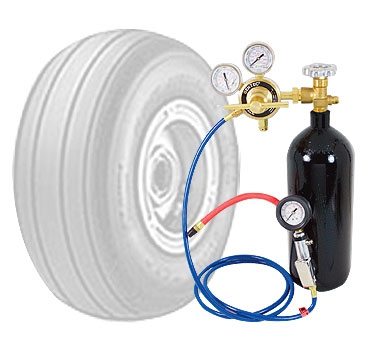 Maintaining proper tire pressure is more important than the composition of the air in the tire. Properly inflated tires handle better, may get better gas mileage, wear more evenly, and can help keep you safer on the road. You can always return to a dealer for a full nitrogen fill when you get to another area.
Maintaining proper tire pressure is more important than the composition of the air in the tire. Properly inflated tires handle better, may get better gas mileage, wear more evenly, and can help keep you safer on the road. You can always return to a dealer for a full nitrogen fill when you get to another area.
Make sure to verify the correct tire size for your vehicle.
Hearst Autos Gear Team The Hearst Autos Gear Team is dedicated to bringing you the very best in automotive tools, parts, and accessories, based on the expertise of the editors of Car and Driver, Road & Track, and Autoweek.
To fill tires with nitrogen, a Nitrogen Tire Inflation System (which is a service usually available at local tire shops) uses a membrane to separate the nitrogen, passing it along through a compressor to your tires. Photo courtesy of Elizabeth AutoCare.
Photo courtesy of Elizabeth AutoCare.
For years, some representatives in the tire industry have been pushing the idea of using nitrogen-filled tires instead of air. The arguments for using this inert gas for tire inflation are myriad.
Nitrogen molecules are larger than oxygen molecules and are less permeable. The result? Tires with nitrogen keep the proper pressure longer. This means you’ll spend less time filling your tires. Additionally, a properly inflated tire lasts longer and offers better fuel economy.
Further, nitrogen fill systems are dry and don’t dispense water vapor into the tire. No water in the tire means the rim will have less of a tendency to rust (at least for certain rims that are not made of aluminum), thus it will last longer. When water vapor is present in compressed air and put under pressure into a tire, it will likely condense and end up as liquid water.
“The likelihood of creating any significant damage is pretty slim,” says 40-year tire expert, Roger Marble.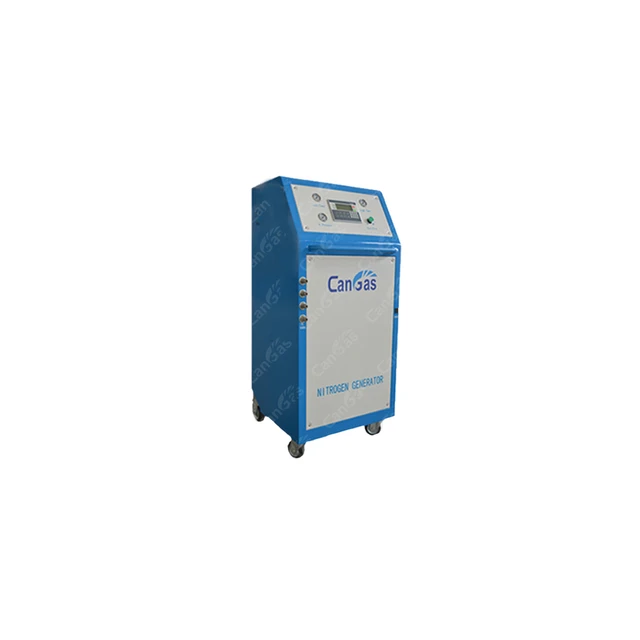 Marble explains that corrosion issues are typically on the outside of the rim, rather than in the air chamber. He reports he doesn’t ever recall seeing any serious corrosion issues in an air chamber.
Marble explains that corrosion issues are typically on the outside of the rim, rather than in the air chamber. He reports he doesn’t ever recall seeing any serious corrosion issues in an air chamber.
Nitrogen fill systems are dry and don’t dispense water vapor into the tire, meaning certain rims will have less of a tendency to rust. Photo courtesy of iRV2.com member, Cheepjeep80.
So, is using nitrogen in your RV tires a good idea or is it really a lot of hot air? Nitrogen is an inert gas and doesn’t support combustion. It’s a pretty common gas. Seventy-eight percent of what you breathe is nitrogen, 21 percent is oxygen, and the remaining 1 percent is a mixture of other gasses. To fill tires with nitrogen, a Nitrogen Tire Inflation System (which is a service usually offered at local tire shops) uses a membrane to separate the nitrogen, passing it along through a compressor to your tires. The nitrogen content coming out of a nitrogen fill hose needs to be at least 93 percent pure.
The Environmental Protection Agency points out that poorly inflated tires on American roads consume millions of gallons of fuel needlessly. Does nitrogen make a difference? If your tires are kept at the proper inflation rate, it doesn’t matter if you’re using nitrogen or oxygen. There is no scientific basis to suggest that nitrogen itself will deliver better fuel economy.
Here is some additional insight on using nitrogen-filled tires (video courtesy of Elizabeth AutoCare):
On the other side of the coin, filling your tires with nitrogen is more expensive than air. The Get Nitrogen Institute says this about cost:
“The average cost to fill a tire can vary from anywhere from $3-$10 per tire. This depends on several variables including tire size and tire pressure. It also depends on whether the dealer chooses to bundle any other services in with the nitrogen fill.
The cost usually includes top-offs for as long as you own the tires.”
If you’re pulling a fifth wheel and using nitrogen that will include four tires for your tow vehicle, plus your trailer tires and two spares. This equates to a minimum of 10 tires. Add two more for a dually towing unit and two more for a triple-axle trailer. This may cost anywhere from $30 to $100 minimum to fill your tires.
Now, what happens when you’re out on the road, away from your free top-offs? You can certainly do it with free or low-cost air or you can look to pay through the hose for nitrogen, provided you can find a provider within a safe distance. If you use air, you’ll later want to get those tires purged and refilled again.
Low tire pressure while on the road? Nitrogen Tire Inflation Systems are usually available at local tire shops. Photo courtesy of aauummm iRV2.com member
If nitrogen is your decision, here’s a pointer from the pros. Tires need to be purged of air to be filled properly with nitrogen. This typically calls for three or so cycles of filling, deflating, and then filling again with nitrogen. Do not allow the tire folks to “vacuum” out your tire, causing it to turn in on itself. That’s about the equivalent of deliberately trotting your tire through a pothole, in terms of potential tire damage.
This typically calls for three or so cycles of filling, deflating, and then filling again with nitrogen. Do not allow the tire folks to “vacuum” out your tire, causing it to turn in on itself. That’s about the equivalent of deliberately trotting your tire through a pothole, in terms of potential tire damage.
You may also want to invest in a good tire gauge. A “needle on the dial” gauge is better than the “pen-style” A relatively inexpensive digital electronic gauge is good as well. You may need to check your tire pressure at least weekly or every time you pull out with your rig. Keep the pressures inflated to the recommended level, based on load weight. That’ll help keep costs down at the fuel pump.
Still worried about potential damage from water vapor in compressed air? One RVer I know of uses the “el-cheapo” method. Before he sticks the air line on his tire valve, he blasts the air across his finger. In the event there’s a lot of wetness, he keeps blasting to see if perhaps the water vapor had simply accumulated in the hose. When it doesn’t yield dry air, then he moves along to another air purveyor.
When it doesn’t yield dry air, then he moves along to another air purveyor.
If there is still a concern, purchase a desiccant filled airline filter, which goes between an air tool and a compressed air line. The filter removes moisture out of the air. When it needs replacing, the desiccant in the filter changes color. Yes, you’ll have to do a little plumbing 101 to get a fitting on the inlet side to reach the air chuck, then put another air chuck on the outlet side. Nonetheless, you can rest easier knowing you’ve dehumidified your tire fills.
The benefits of using nitrogen to inflate (refill) wheels and tires are as follows:

In addition, it is important to elaborate on the advantages that filling a tire with nitrogen will give you compared to filling a wheel with air.
Advantages of filling a tire with nitrogen compared to filling a wheel with air:

All these factors contribute not only to improving the performance of the tire, but also ensures the safety of the car on any road.
As a result, each car owner must clearly understand for himself that inflation (filling) of a tire with nitrogen has a number of advantages that not only help prolong the tire's performance, but also ensure comfort and safety on the road.
In summary, let's once again name the main advantages of pumping (filling) wheels with nitrogen:

class="w1000">
In our branch on the street. Sorge, d. 7A there is a cafe. In it, you can comfortably spend time watching the work on your car on the monitors, as well as using high-speed free WI-FI.
Car wash. Dry cleaning. Polishing
Wheel bead polishing
Professional tire service
Glass repair
Removing bolts/secrets
We accept for payment:
UNIFIED INFORMATION:
+7 (495) 799-02-20
24/7
remontdiskov@mail.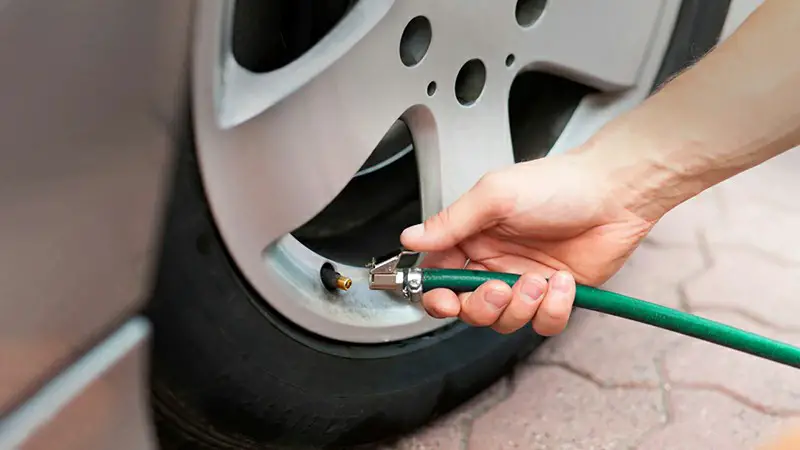 ru
ru
ProfShinService
group of companies
Please introduce yourself
or
Select branch
Anokhina Zorge Rusakovskaya International Malygina Question to the DirectorYour question
x
Login or register
One of the latest trends in our automotive services market is the use of nitrogen in tires. Fans of this method assure a significant reduction in fuel consumption. It is also believed that the wheels practically do not go down due to the larger size of the gas molecule compared to air. Many tire fitting stations and service centers offer refueling of tires with this gas.
There are also opponents of the method who completely dismiss all the arguments of the supporters. Their main argument is the well-known fact that air is 78% nitrogen, 21% oxygen and other gases.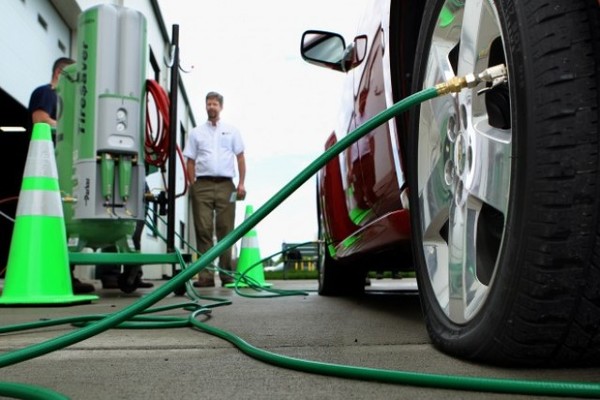 Question: why inject another 15% nitrogen? It is unlikely that an additional volume of gas can dramatically improve the performance of a car tire. Moreover, this service costs more.
Question: why inject another 15% nitrogen? It is unlikely that an additional volume of gas can dramatically improve the performance of a car tire. Moreover, this service costs more.
Let's look into the situation, consider all the pros and cons of nitrogen in tires.
In the automotive world, pumping nitrogen into tires has been around for a long time. True, this method was first used in the "royal" class of racing - Formula 1. However, like most other technologies that have been tested on cars before manufacturers start using them on production cars. In this case, an air-nitrogen mixture was used, and not pure gas. The method was first used in the middle of the last century.
In the case of Formula 1, the use of this method provides at least one big plus - increased safety. The fact is that in the event of a car igniting, the air from the burst tire is an oxygen blower, igniting the flame even more. In the case of nitrogen injection into tires, this effect will no longer be, that is, the risk of fire is reduced.
In the US, nitrogen is used instead of air in tires in commercial vehicles. This is not a mandatory rule, but many truck owners and carriers use alternatives.
In ordinary life, cars are not often used to the limit of their capabilities, fires occur very rarely. Therefore, pumping gas instead of air just for the sake of greater safety is impractical, but there are other advantages.
Nitrogen tire inflation has both supporters and opponents. Moreover, they are present among professionals, including owners of tire stations and service stations, and among amateurs. The advantages of the method include:
This is one of the most common arguments for nitrogen instead of air.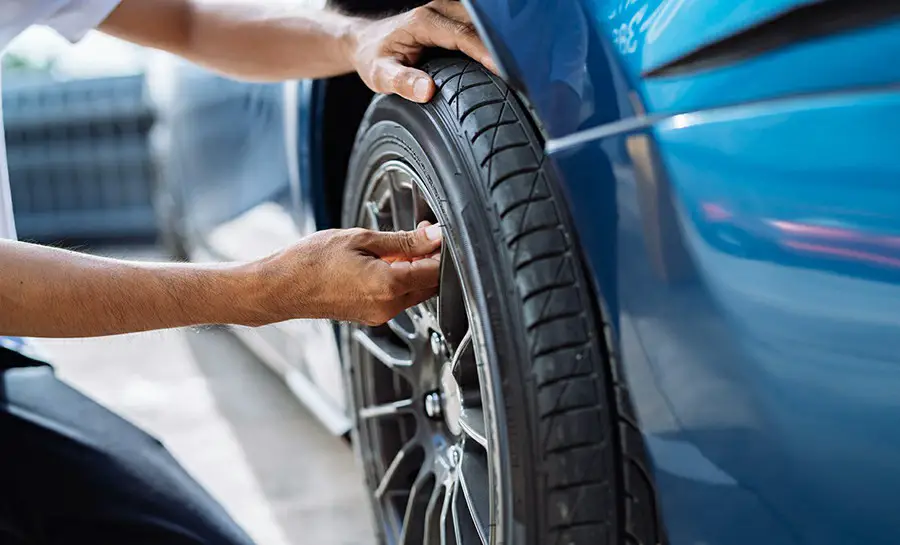 Its essence boils down to the fact that the specified gas is lighter than air, respectively, the lower weight of the wheel will lead to a decrease in fuel consumption.
Its essence boils down to the fact that the specified gas is lighter than air, respectively, the lower weight of the wheel will lead to a decrease in fuel consumption.
To do this, you need to deal with real numbers. A cubic meter of air, which is pumped into tires, has a weight of 1.29 kg, and a cubic meter of gas - 1.25 kg. A standard passenger car wheel holds about 75 grams of pure gas and 77 grams of air mixture. Therefore, the difference in fully inflated wheels will be a few grams, which is negligible for significant fuel savings.
The difference is almost imperceptible - much more weight on the wheel adds dirt between the treads or pebbles.
Summer Drive Protection Sound Comfort
Rating:
4.5
Tires Goodyear Eagle F1 Asymmetric 3 SUV
Summer Drive protection
Rating:
4.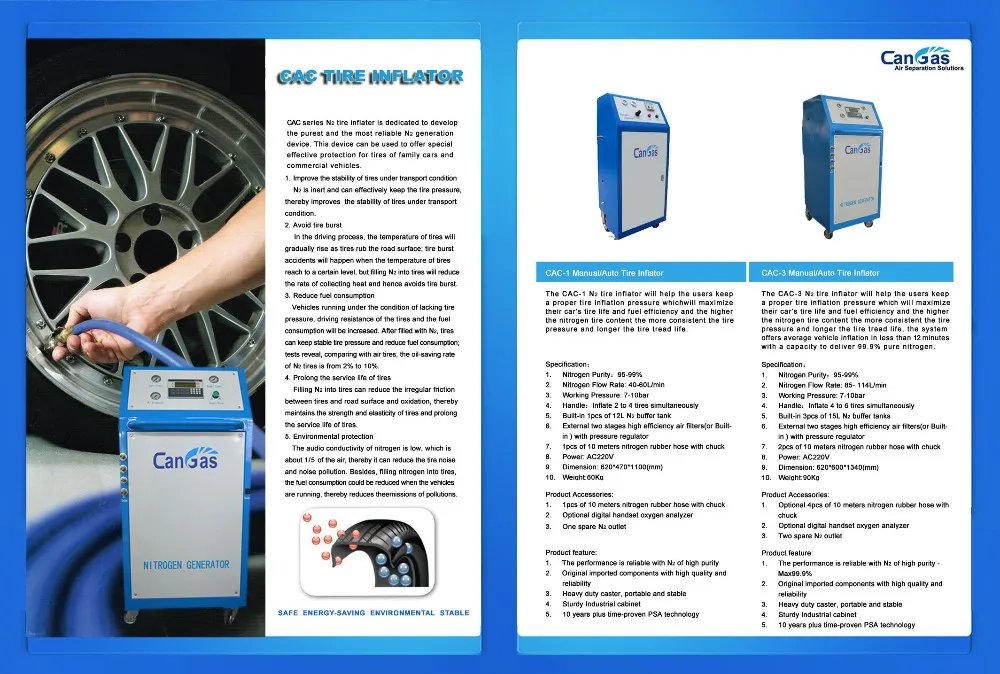 5
5
Tires Goodyear Eagle Sport TZ
Summer Drive protection
Rating:
4.5
Tires Goodyear EfficientGrip 2 SUV
Summer Drive Protection Run On Flat
Rating:
4.5
Tires Goodyear EfficientGrip Performance
Winter Drive protection
Tires Goodyear UltraGrip Arctic 2 SUV
Winter Drive Protection Sound Comfort
Rating:
4.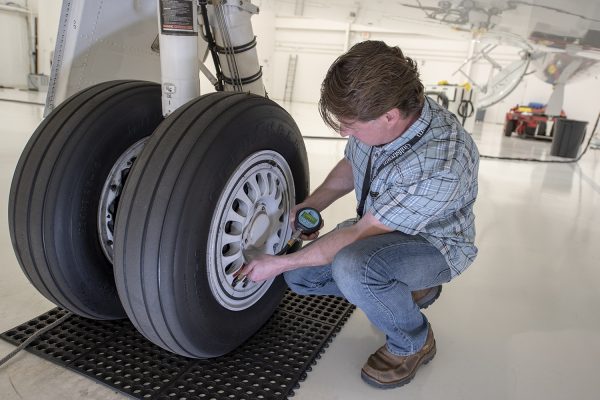 5
5
Tires Goodyear UltraGrip Ice 2
Winter Drive Protection Sound Comfort
Rating:
4.5
Tires Goodyear UltraGrip Ice SUV
Winter Drive protection
Tires Goodyear UltraGrip Performance+ SUV
All season Drive Protection
Rating:
5
Tires Goodyear Vector 4Seasons Gen-3 SUV
Summer Drive Protection Run On Flat
Rating:
4
Tires Goodyear Wrangler HP All Weather
All season Drive Protection
Rating:
4.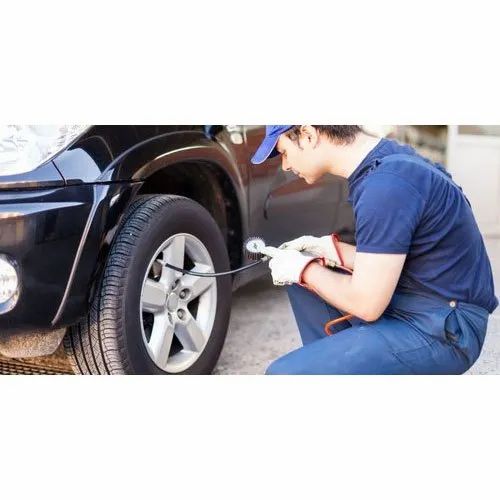 5
5
Tires Goodyear Vector 4Seasons
Summer
Rating:
4.5
Tires Goodyear Wrangler All-Terrain Adventure with Kevlar
Summer Drive Protection
Rating:
4.5
Tires Goodyear EfficientGrip SUV
Summer Drive Protection Run On Flat
Rating:
4
Tires Goodyear Eagle F1 Asymmetric SUV
Stable pressure is another argument for fans to pump nitrogen into the wheel instead of regular air.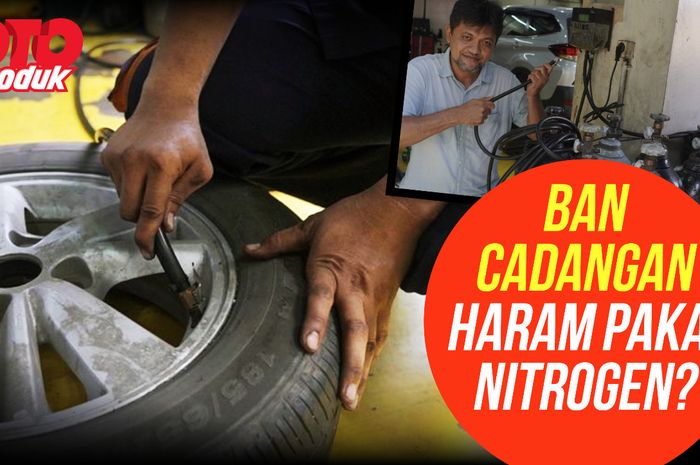 In this case, the argument is the larger size of the gas molecule compared to the size of the oxygen molecule. Accordingly, oxygen seeps through microscopic cracks and holes in the tire faster. As a result, the pressure drops and the wheel lowers.
In this case, the argument is the larger size of the gas molecule compared to the size of the oxygen molecule. Accordingly, oxygen seeps through microscopic cracks and holes in the tire faster. As a result, the pressure drops and the wheel lowers.
Yes, it is. But do not forget that ordinary atmospheric air is 78% nitrogen, and only 21% oxygen. Therefore, when the pressure drops in the wheel, it is pumped up, thus adding even more nitrogen from ordinary air. For several years of operation, the wheel is almost completely inflated with gas alone.
Nitrogen practically does not expand when heated, so the pressure in the tire will remain the same as the temperature changes. In contrast to this statement, it is worth noting that more than three-quarters of the air is occupied by nitrogen. Other gases also do not expand much, so the pressure difference in tires filled with air or nitrogen when heated is not too great to take into account.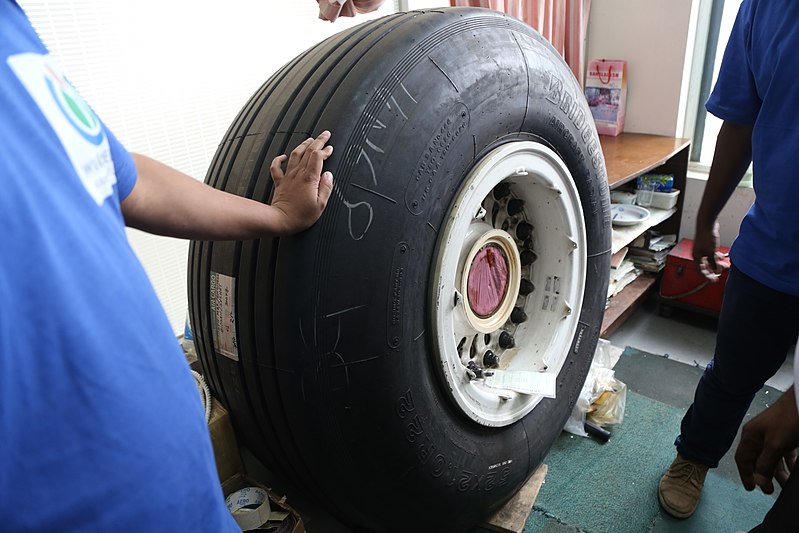
Proponents of the method claim that the absence of oxygen provides additional protection for the material from aging. Yes, this is a fair remark, but does it make any practical sense? Rubber is exposed to other factors - aggressive environment, moisture, sunlight, and so on. All this does not contribute to the extension of service life, but no one is going to use tires forever. There are certain operating times that are not significantly affected by the gas used.
A lower noise level indicates a tire filled with clean gas rather than atmospheric air. Yes, by simple measurements at a speed of 100 km / h, the noise level in the first case is 65 dB versus 68 dB in the second. Is it good or bad? Just imperceptibly - a difference of 3 dB is absolutely negligible.
A wheel filled with nitrogen is less likely to explode. In fact, the wheel will explode only in the case of ruthless operation of the car, which is very rare in ordinary life. Moreover, in fact, the wheel does not explode, but bursts - there is a sharp loss of pressure when the tire structure is destroyed.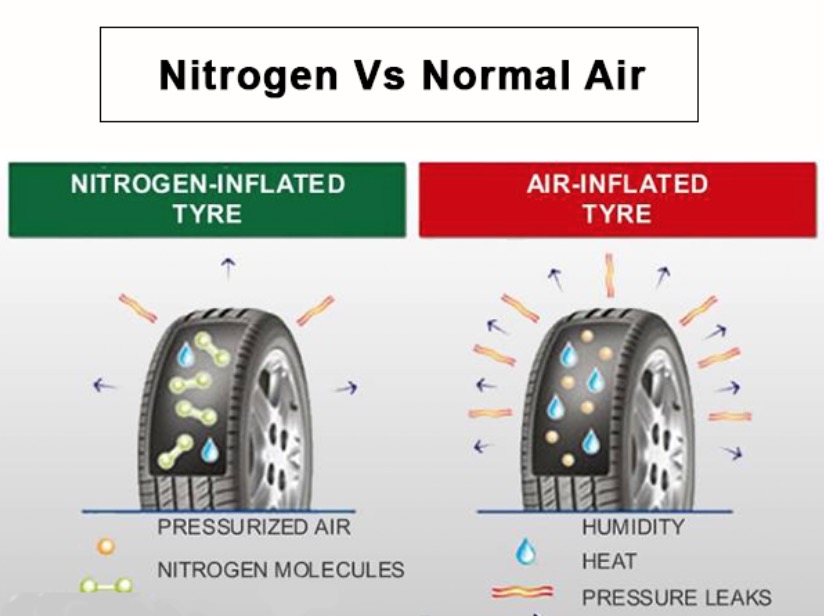 And this can happen when hitting an object or obstacle.
And this can happen when hitting an object or obstacle.
Also, do not pay serious attention to the advice of those who recommend less checking the tire pressure with nitrogen. Checking should be done as often as the manufacturer recommends, and the number of checks does not depend on the type of mixture. How much the wheel “holds” is largely influenced by the composition of the rubber, its condition. A normal tire without damage is able to hold pressure for years
But metal corrosion is more pronounced when air is used. The oxygen contained in it is an oxidizing agent. It enters into a chemical oxidation reaction even at low temperatures, affecting the wheel and rubber. This statement can be attributed to the really positive aspects of nitrogen injection.
The downside of using nitrogen instead of air in your car tire can be the price. After all, the technology provides for the removal of air from the wheel and then the injection of clean gas instead. Naturally, you need to think carefully about whether it is necessary to pump in nitrogen, or whether it is better to use the traditional method. We did not find significant advantages, representatives of the main tire brands have a similar opinion. To determine why to do this, you need to think carefully, because there are no pronounced advantages.
Naturally, you need to think carefully about whether it is necessary to pump in nitrogen, or whether it is better to use the traditional method. We did not find significant advantages, representatives of the main tire brands have a similar opinion. To determine why to do this, you need to think carefully, because there are no pronounced advantages.
Another disadvantage is the need to use special equipment, gas cylinders are also needed. This can only be afforded by special service centers for car maintenance, tire shops. Any car owner can inflate a tire with a compressor or even a simple pump, for this it is not necessary to be a professional. With nitrogen, this will not work - in a garage or in the middle of a highway you will not be able to pump gas, at least without the appropriate equipment.
The following shortcoming cannot be called a pure disadvantage of the method, but still its opponents often talk about it. The essence of their refutation boils down to the fact that in simple air the nitrogen content is at least 78%, so it makes no sense to pump in an additional 15%.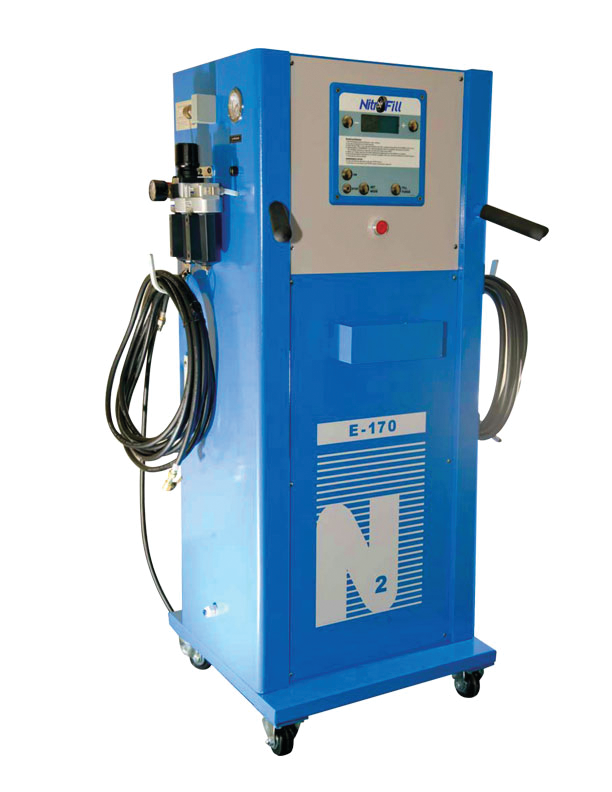
The argument for using nitrogen in tires is the smooth running of the vehicle. There is no obvious confirmation of this advantage, just the pressure in this case is slightly less - the wheel is under-inflated, which ensures smooth movement on uneven road surfaces.
It is a clear myth that when a tire is punctured, gas escapes more slowly than pure air. The reason for this is the larger size of its molecule. This is not true, and any puncture can “empty” the wheel in a matter of moments.
For example, in the rules of the notorious Formula 1, the elite of motorsport, there is no mandatory requirement to use nitrogen exclusively. Choice is provided, which means there is no advantage of one method over another. For road cars, the situation is similar, but with one clarification. The cost of using nitrogen in vehicle tires is much higher and this is a significant disadvantage. The question arises - why overpay if there are no benefits as such? The answer depends solely on the preferences of a particular car owner.